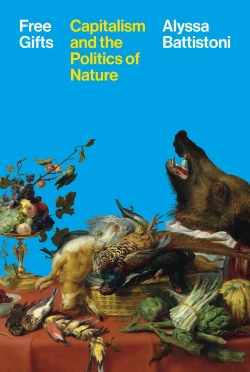In a world beset by interlinked ecological and political crises, Alyssa Battistoni’s Free Gifts: Capitalism and the Politics of Nature addresses two weighty questions: What is the nature of value, and what is the value of nature? Early political economists debated the role of natural agents in the production of wealth, but it was Marx—in his analysis of the way human labor generates value for capital—who articulated the peculiar appearance of nature under capitalism as a free gift. Battistoni follows through on this marginal insight in Marx’s critique of political economy. Although it might at first sound redundant or oxymoronic, she differentiates the free gift from the gifts of nature bestowed within the parameters of reciprocity and relational responsibilities (as Winona LaDuke and Robin Wall Kimmerer describe in Anishinaabe and Potawatomi societies) and from the object of a unidirectional act of divine grace characteristic of Western theological understandings of the natural world.1See Winona LaDuke, All Our Relations: Native Struggles for Land and Life (South End Press, 1999); Robin Wall Kimmerer, Braiding Sweetgrass: Indigenous Wisdom, Scientific Knowledge and the Teachings of Plants (Milkweed Editions, 2015). Where these notions of the gift signal exceptions to the realm of commercial exchange, the free gift is intelligible only in relation to the market—that is, to the sphere in which “most things have a price.”2Alyssa Battistoni, Free Gifts: Capitalism and the Politics of Nature (Princeton University Press, 2025), 36. What the free of the “free gift of nature” signals is the costlessness of materially useful nature under a capitalist organization of activities. The free gift of nature is therefore a phenomenon that appears only in a world structured around three defining features: the division of human beings into a class that owns the means of production and one forced to sell its labor, the generalized exchange of commodities, and our dependence upon the market as the primary means of acquiring the necessities of life. It is by following the vicissitudes of the free gift of nature, Battistoni argues, that we can track how capitalism consistently fails to value nonhuman nature and what that means for our collective political prospects.
Although one conclusion of this wonderful book is that nothing comes for free, Free Gifts is itself a gift for those in the environmental humanities, political theory, and feminist thought. Much early environmental thought focused on how harmful forms of anthropocentrism or the dualistic separation of the natural world from human society underwrite ecological degradation at various scales.3For a historical survey and commentary on the critiques of anthropocentrism within deep ecology, see Nina Witoszek and Andrew Brennan, eds., Philosophical Dialogues: Arne Næss and the Progress of Ecophilosophy (Rowman & Littlefield, 1999). For a sustained analysis of nature/culture dualism and its consequences for nonhumans and gendered and racialized others, see Val Plumwood, Feminism and the Mastery of Nature (Routledge, 1993); Val Plumwood, Environmental Culture: The Ecological Crisis of Reason (Routledge, 2002). Contemporary discussions in environmental ethics often drill down on new paradigms for moralizing individual and collective contributions to climate change or debate whether rich or poor countries should lead in bearing the costs of climate change.4See Stephen M. Gardiner et al., eds., Climate Ethics: Essential Readings (Oxford University Press, 2010). In Free Gifts, Battistoni attends to the structural and material conditions subtending many of these debates, arguing that “one of the densest sites of interaction between ‘nature’ and ‘society’ is in the material realm we call the economy” and that the free gift of nature illuminates the limitations of capital for valuing nonhuman nature, human labor, and reproductive work.5Battistoni, Free Gifts, 7.
Battistoni’s analysis is both fine-grained and expansive as she develops a conceptual framework for nature’s treatment in a world oriented by market logics. Free Gifts therefore begins with a careful formal examination of how forces, beings, and things enter into our economic relations. As the investigation moves through the factory, the home, and the very biosphere, the book also tracks the concrete ways physical and biological processes both resist easy incorporation into capital’s designs and inform material production processes. A powerful aspect of the text includes Battistoni’s engagement with economic and political thinkers as she traces the shortcomings of extant critical social theory for directly addressing the material, earthbound conditions of existence.
In addition, she ultimately argues that not only does capitalism threaten the conditions for human and more-than-human life, but it also limits human freedom. Drawing on Simone de Beauvoir’s discussion of the inherent ambiguity of the human condition—we are historically and materially situated, and yet to be human is to determine our own values and projects—Battistoni develops an antifoundationalist critique of capitalism’s constraints on our embodied and emplaced collective ways of life. In overdetermining our relationships with the more-than-human world, capitalism limits the possibilities for living differently and for valuing nature as more than nothing.


